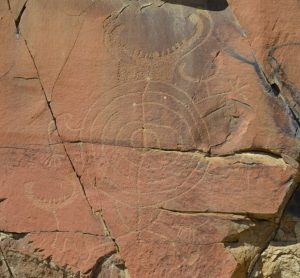Meeteetse Museums Legend Rock Tour 2021
By Dr. Lawrence Loendorf
Saturday June 19, 2021, the Meeteetse Museums will sponsor a tour of the Legend Rock petroglyph site located between Meeteetse and Thermopolis, Wyoming. The tour leader is Dr. Lawrence Loendorf, an archaeologist who has worked in the southern Montana and northern Wyoming region for the past sixty years. He originally worked in Montana as a “dirt archaeologist” but about forty years ago, he emphasized the study of rock art sites. He has several books and numerous articles about regional rock art sites, including Legend Rock. Loendorf will sign books at the end of each tour and the Museums will have limited books on site available for purchase.
The Legend Rock tours are limited to ten individuals per tour and Loendorf will lead two tours for the Meeteetse Museums on June 19. Each tour will begin with a ten-minute PowerPoint presentation in the small visitor center at Legend Rock and last about an hour. With these small group tours there will be ample time to ask questions and offer insights.
There are hundreds of rock art sites across North America, some that are large and significant, but archaeologists consider Legend Rock to be an extremely important site because the petroglyphs have substantial time depth and many of them represent the Dinwoody Tradition. Dinwoody Tradition petroglyphs are linked to the Mountain Shoshone or Sheep Eater Indians. This makes Legend Rock important because it is unusual to find a site with such a long record of use by a traditional group of people. There is substantial evidence that the Sheep Eater Indians, who moved in the winter months from the mountains surrounding Yellowstone National Park to the lowlands around the Thermopolis hot springs, followed this practice for 3000 to 4000 years.
It should not be surprising that there is change in what figures were left at the site in that length of time. However, shamanism is the single constant force that influenced the making of the Dinwoody petroglyphs. The Mountain Shoshone believed there were powerful spirits or ghosts living in the hot springs at Thermopolis and these same spirits lived in the hot springs in Yellowstone. Further there was an underground channel, filled with hot water, that connected Thermopolis to the Park, and the water ghosts could come up through cracks in the rock until the reached the surface.

In the photograph above, the water is represented by the concentric circles –like the rings left when a stone is tossed into water. The attached horned heads, the extra feet and hands are the remnants of the ghosts. Note how the circles are centered on a large crack in the rock where the ghosts came out of the underground waterway.
The water ghosts would befriend a Shoshone who had the courage to pray and fast while waiting through the nights and days in front of the rock. The ghosts or ogres would then give power to the initiate for healing the sick, success in warfare, or many other pursuits. The petroglyphs reflect the power, the ghosts, and the experience. They were on some occasions revisited to renew the individual’s power.
It is important to recognize that when the Sheep Eater Indians made their initial visits to Legend Rock, they found the site had already been used by other groups to leave petroglyphs. These older petroglyphs that emphasize animals like elk, deer and bighorn sheep may date to 6000 to 7000 years ago and perhaps older. There are also more recent petroglyphs at the site left by the Plains Shoshone, Crow Indians, and possibly Arapaho and Cheyenne groups.

